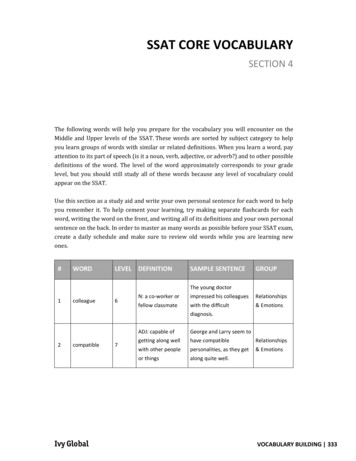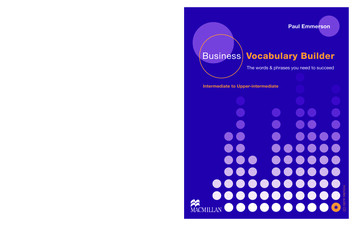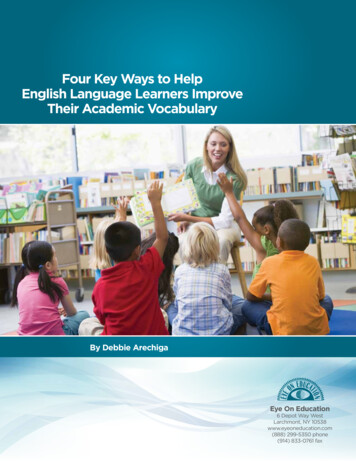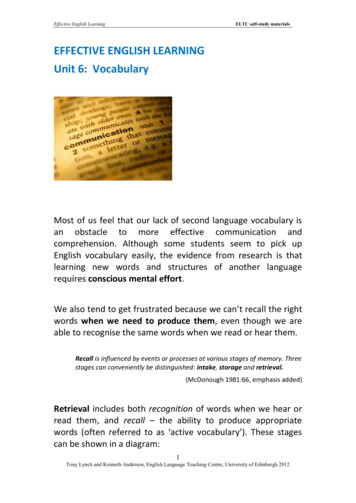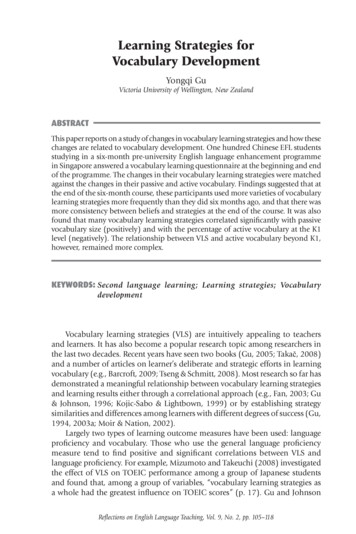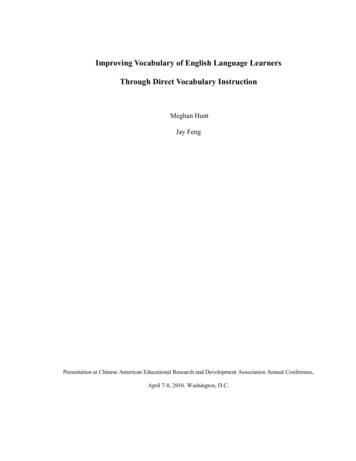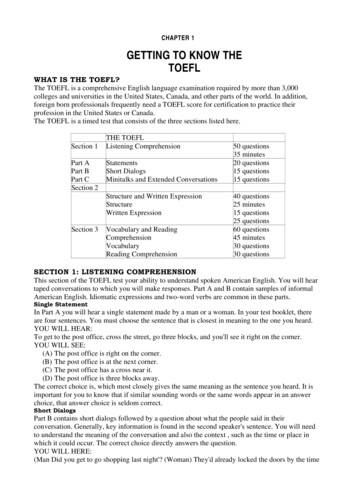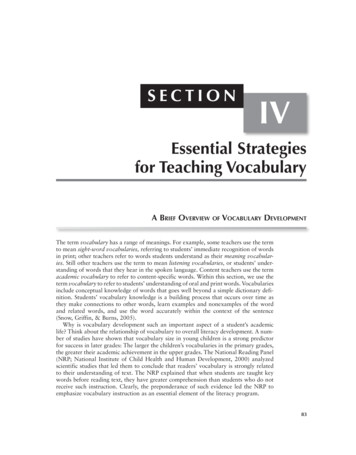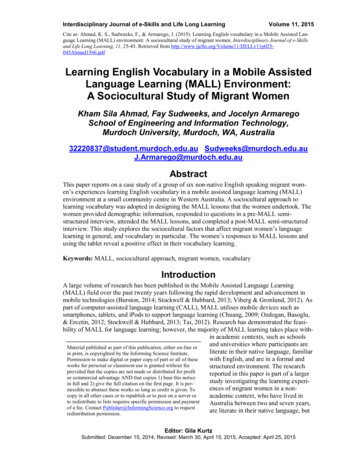
Transcription
Interdisciplinary Journal of e-Skills and Life Long LearningVolume 11, 2015Cite as: Ahmad, K. S., Sudweeks, F., & Armarego, J. (2015). Learning English vocabulary in a Mobile Assisted Language Learning (MALL) environment: A sociocultural study of migrant women. Interdisciplinary Journal of e-Skillsand Life Long Learning, 11, 25-45. Retrieved from d1566.pdfLearning English Vocabulary in a Mobile AssistedLanguage Learning (MALL) Environment:A Sociocultural Study of Migrant WomenKham Sila Ahmad, Fay Sudweeks, and Jocelyn ArmaregoSchool of Engineering and Information Technology,Murdoch University, Murdoch, WA, Australia32220837@student.murdoch.edu.au stractThis paper reports on a case study of a group of six non-native English speaking migrant women’s experiences learning English vocabulary in a mobile assisted language learning (MALL)environment at a small community centre in Western Australia. A sociocultural approach tolearning vocabulary was adopted in designing the MALL lessons that the women undertook. Thewomen provided demographic information, responded to questions in a pre-MALL semistructured interview, attended the MALL lessons, and completed a post-MALL semi-structuredinterview. This study explores the sociocultural factors that affect migrant women’s languagelearning in general, and vocabulary in particular. The women’s responses to MALL lessons andusing the tablet reveal a positive effect in their vocabulary learning.Keywords: MALL, sociocultural approach, migrant women, vocabularyIntroductionA large volume of research has been published in the Mobile Assisted Language Learning(MALL) field over the past twenty years following the rapid development and advancement inmobile technologies (Burston, 2014; Stockwell & Hubbard, 2013; Viberg & Gronlund, 2012). Aspart of computer-assisted language learning (CALL), MALL utilises mobile devices such assmartphones, tablets, and iPods to support language learning (Chuang, 2009; Ozdogan, Basoglu,& Ercetin, 2012; Stockwell & Hubbard, 2013; Tai, 2012). Research has demonstrated the feasibility of MALL for language learning; however, the majority of MALL learning takes place within academic contexts, such as schoolsand universities where participants areMaterial published as part of this publication, either on-line orliterate in their native language, familiarin print, is copyrighted by the Informing Science Institute.with English, and are in a formal andPermission to make digital or paper copy of part or all of theseworks for personal or classroom use is granted without feestructured environment. The researchprovided that the copies are not made or distributed for profitreported in this paper is part of a largeror commercial advantage AND that copies 1) bear this noticestudy investigating the learning experiin full and 2) give the full citation on the first page. It is perences of migrant women in a nonmissible to abstract these works so long as credit is given. Tocopy in all other cases or to republish or to post on a server oracademic context, who have lived into redistribute to lists requires specific permission and paymentAustralia between two and seven years,of a fee. Contact Publisher@InformingScience.org to requestare literate in their native language, butredistribution permission.Editor: Gila KurtzSubmitted: December 15, 2014; Revised: March 30, April 15, 2015, Accepted: April 25, 2015
Learning English Vocabulary in a MALL Environment: A Sociocultural Study of Migrant Womenare struggling with English. In Australia, proficiency of the English language is essential for general social interaction, furthering education and employment (ASIB, 2012; Bimrose & McNair,2011; Colic-Peisker & Tilbury, 2007; Fozdar & Hartley, 2012; Smolicz & Secombe, 2003).This study focuses on the sociocultural factors that affect migrant women’s language learning ingeneral and vocabulary acquisition in particular. This study specifically addresses vocabulary acquisition as it is a branch of language that is important for second language oral proficiency (J.Ahmad, 2011; Choo, Lin, & Pandian, 2012; Coady & Huckin, 1997). Vocabulary acquisition,centering on the speaking and listening branch of language development, is seen as useful andbeneficial for migrant women to develop general English proficiency (K. S. Ahmad, Armarego,& Sudweeks, 2013). The approach to learning vocabulary adopted in this study is supported byHalliday’s (2004) and Vygotsky (1978)’s sociocultural theory.BackgroundFor this study, the term ‘migrant women’ refers to women who enter Australia under the familyreunion program or for humanitarian reasons. Typically, the purpose of migration is to build anew and better life for families; however, the causes of migration can be “personal and voluntary”or “forced” due to political turmoil, threats to their lives, violence, famine, or war (Kunz, 1973;UN, 2013; UNHCR, 2011; Ward, Bochner, & Furnham, 2001). Settlement into a new life includes having to learn and adapt to a new culture, dealing with emotional and psychological issues, dealing with sociocultural and socioeconomic challenges, and learning English as a newlanguage (OMI, 2012). The lack of English language proficiency is one of the common barriersfor migrants’ settlement in Australia (Coates & Carr, 2005; Colic-Peisker & Tilbury, 2007;Fozdar & Hartley, 2012; Migliorino, 2011). For women, this barrier cannot be overcome as quickly as for men. To some extent, pressures of family duties, staying at home and engaging in fulltime care of families, leads to isolation from the broader community for several years. As a consequence, finding employment can be a challenging and overwhelming experience. Personal andsociocultural factors are the important influences in the lives of these women (AMES, 2011;ECCV, 2009; McMichael & Manderson, 2004). It has been observed (K. S. Ahmad et al., 2013;RCOA, 2010) that, in terms of these women learning English, the programs offered by local andnon-profit community-based centres are the best alternative to the formal government-fundedprograms. Even though the former is non-accredited and short term, it is the kind of learning opportunity and space that suits their needs for a friendly and non-rigid learning environment thatallows them to learn and practise basic speaking and conversational skills.The case study for this research is a community centre in Western Australia, which is a non-profitorganization providing community access to both formal and informal learning opportunities aswell as community services and referrals to other agencies. The first author of this paper is a facilitator of an English program for adult migrants at the centre. The objective of the English programis to provide a learning space for people to meet and socialise with others who also want to practise spoken English. Their main motivation for attending the program is to learn, practise, andimprove their basic conversational and other language skills. The program is open to both menand women; however, the majority of participants are women.Integrating MALL into this particular community English program includes using a mobile device, that is, a tablet as a learning tool. This inclusion of a mobile device enriches the learningexperience because the features of these devices can enhance the delivery of learning materials. Assuggested by Klopfer, Squire, and Jenkins (2002), these features include connectivity, contextsensitivity, individuality, portability, and social interactivity. Regardless of the learners’ location,they can access learning materials and activities spontaneously. The learner and the mobile devices are both portable as the learner can access and be connected online. The learner has a choicewhether to use the mobile device individually and personalize his/her learning to or learn collabo26
Ahmad, Sudweeks, & Armaregoratively with other learners (Cavus & Ibrahim, 2009). MALL can also be used in a blended setting where in-classroom instruction is combined with out-of-class instruction, thus maximisingthe benefits of in-class, face-to-face, and online learning (Tai, 2012). In the context of this casestudy, the integration of MALL also helps develop digital literacy skills among these women.This is because, by learning how to use a mobile device, the women can use it for other learningsuch as other life skills. Familiarity with the mobile devices facilitates access to useful websitesand networks (social, government, or career), thus reducing isolation in their lives. Being proficient in English and being digitally proficient also increases the chances of being included(Migliorino, 2011) into the highly digital literate Australian culture and society (Thomson & DeBortoli, 2012).Learning English and MALL through the Lens of SocioculturalTheoryThe approach to learning vocabulary adopted in this study is supported by the sociocultural theory of Halliday (2004) and Vygotsky (1978). Both theorists emphasise that language learning isprimarily a social activity and the learners should be involved in negotiating and make meaningin authentic social and cultural activities. Following Grabinger, Aplin, and Ponnappa-Brenner’s(2007) idea of social cultural learning environment, learners should become familiar with thesocial norms and discourse of the target language. Learners should also be given the opportunityto apply them in an authentic way. Vocabulary learning is not only about acquiring the meaningand knowledge of the words or phrases but also being able to use them for meaningful communication.According to O’Neill and Gish (2008), in learning a second language, successful cross-culturalunderstanding and intercultural literacy for both learners and their teacher/facilitator is requiredwhere learning experiences should take place in a variety of sociocultural settings. This can beachieved through a process of continual “constructing, interpreting, and modifying their representations of reality based upon experience and negotiation of meaning with others” (Grabinger etal., 2007, p. 2). According to Burgoyne and Hull (2007), this continual process allows individualsto become members of the group in which they play a part by assuming the emerging identity thatis associated with the language that they are learning. In addition, the principle of participationfortifies the viewing of learning as a collaborative process and as a way of transformingknowledge making. This allows participants to shape the process and products of knowledge(O’Byrne, 2003). Through interactions, individuals engage with each other and they constructknowledge through their social and cultural practices. Martin and Rose (2005) emphasise that coconstruction of knowledge makes new learning possible within the continuing practice and socialenvironment. Billet (1998) posits that, without continual participation in social practice,knowledge will not be accessible, thus learning outcomes are likely to be inhibited. Therefore,successful communication in English requires participation in a social practice and involves alltraits of an individual’s sense of social identity and social resources. On this basis, a socioculturalapproach is adopted in this case study in designing the MALL integrated vocabulary lessons forthe participants.In designing vocabulary lessons incorporating MALL concepts for adult learners, considerationshould be given to principles of andragogy (Knowles, 1984) that are widely used for developingadult learning curricula. These principles are based on five crucial suppositions about adult learners’ characteristics that differ from children’s pedagogy: self-directed; equipped with experience;ready to learn; oriented toward being problem-centred rather than subject-centred; and motivated(Smith, 2002). For adult learners, learning English as a second language in general, and Englishvocabulary specifically, is influenced by factors such as level of education in native language(L1), culture, past experiences, age, and opportunities to speak English (Allender, 1998;27
Learning English Vocabulary in a MALL Environment: A Sociocultural Study of Migrant WomenHewagodage & O'Neill, 2010). There is also the need to consider previous psychological andemotional concerns, such as trauma, settlement, and family priorities or confidence and motivational issues (Fozdar & Hartley, 2012). There may also be different understandings among cultures about teaching methodology, teacher-learner rapport, and modern pedagogical practices. Inaddition, the idea of self-assessment, critical discussion, and the physical climate of the learnercentred learning environment may be alienating for some. Thus, the pedagogical approach adopted for adult migrants’ English language learning in general is crucial for language learning success.Among studies that show the feasibility of MALL in language acquisition within formal education settings are those by Alemi, Sarab, and Lari (2012), Cavus and Ibrahim (2009), Chuang(2009), Gu, Gu, and Laffey (2011), and Thornton and Houser (2005). Some of the factors centralto the MALL environment are the characteristics of the mobile devices used. For example, allowing learners to access learning materials without time and space constraints is effective for delivering language learning materials to learners (Thornton & Houser, 2005). In addition, mobile devices are more cost efficient compared to desktop or laptop machines, thus they are more affordable to language learners (Wu et al., 2012). A review of the literature by K. S. Ahmad et al. (2013)suggests that these factors of MALL are potentially beneficial to English learners such as migrantwomen. Further, the suitable area of English language that these learners should focus on is vocabulary. According to J. Ahmad (2011), vocabulary learning is a crucial process for languagelearners to acquire proficiency and competence in a language. Qian (1999) states that vocabularyknowledge refers to the size as well as the depth of vocabulary, which includes knowledge aboutthe contexts in which the word is used, the frequency with which it is used, its morphology, itssyntax, whether it has multiple meanings, pronunciations and spellings, and how the word combines with other words. A wealth of words or a word bank facilitates fluent and effective speaking and writing, whilst other skills (listening, reading, speaking, and writing) are enriched andintegrated as well. The greater the number of words in a learner’s word bank, the more instruments they have with which to put a point on their own ideas, and dissect and examine those ofothers (J. Ahmad, 2011; Elgort, 2011). As such, knowledge of vocabulary is valuable and usefulfor a language learner.Krashen and Terrell (2000) claim that comprehension is not possible without vocabulary. Themore vocabulary is mastered, the better one’s comprehension and thus more acquisition of language occurs. Kenny (2011) also suggests that, in order for humans to acquire other words andsyntax, they will have to initially acquire vocabulary. It is beneficial for language learners to havevocabulary knowledge and be able to use this knowledge in their day-to-day lives. Having a rangeof vocabulary and feeling confident in using it leads to the ability to be clear when sharing ideasand thoughts, or simply when making conversation (J. Ahmad, 2011; Elgort, 2011; Nation &Newton, 2009). This increases the likelihood that other people will understand what is expressed.A diverse vocabulary allows learners to connect with a broader variety of people (Lightbown &Spada, 1993; Mishra, 2010). For example, knowing some business terms assists in not being taken advantage of. Also, vocabulary is essential for comprehending reading materials (Krashen &Terrell, 2000; Lightbown & Spada, 1993). Comprehension of what is being read is hindered dueto unfamiliar words that tend to become little holes in the text. Vocabulary also assists learners inbecoming more informed and involved. For example, learners will have a better understanding ofnews and currents events if they understand politics and geography. Learners will also be able tograsp ideas and think more rationally and incisively.Case StudyThe case study is a small community centre that is a non-profit organization in a suburb in Western Australia. The centre provides community services and learning programs to the surrounding28
Ahmad, Sudweeks, & Armaregocommunity members. One of its programs is learning conversational English, which was startedin 2001. The first author of this paper has been the coordinator and facilitator of this program forthe past two years. The main objective of this program is to provide a non-formal learning spacefor people who want to practise basic conversational and survival English, whilst meeting andsocializing. The program is free of charge, offers a learning atmosphere that is relaxed, supportive, non-threatening and provides a somewhat level playing field for learning. A crèche facility isalso provided for mothers with small children. This program is open once a week, for two hours,during public school terms.Attendance in the program is not compulsory. As such, attendance is irregular, contingent uponparticipants’ availability and convenience. About 40 participants enroll in the program each termwith an average attendance of 12 to 15 per session. Some participants have been regulars for manyyears, though they do not come to every session. The program receives new participants almostevery term, but it is never known whether they will return in successive sessions. Although theprogram is open to both men and women, it has been observed that women attend this program asa way to be able to get out of their house. Thus, in addition to learning English, the program reduces their isolation and allows them to interact, engage, and socialise with other women.The sessions are meant to be non-formal and non-academic, as opposed to formal and structuredEnglish classes. The physical layout of a session includes two large tables where 12 participantscan sit around each table. Upon agreement with the centre’s management, the facilitator plans topics to be included for the 10-session term. Activities may include the following: introducing vocabularies and phrases using pictures and realia, followed by making sentences using learnt vocabularies; eliciting discussions based on topics; role playing and listening to a CD (where participants listen to short dialogues by native English speakers, followed by a discussion); and any current issues or topics that participants want to share with their peers. The whiteboard is used towrite words, phrases, or draw pictures for illustration. Participants who can read and write in theRoman alphabet are able to copy the words on the board fairly quickly. Participants who are ableto read and write in their native language usually copy the words from the board and write notes intheir language. Other participants who struggle or are unable to read and write use their visual andlistening ability and their memory.The sessions are not fast paced, as sometimes more time is needed to describe or explain wordsand concepts, and sometimes participants help and translate for each other. Some repetition drillsare used to help participants become familiar with new vocabularies and phrases. It is observedthat new participants who speak very little English usually only speak when spoken to during theirfirst session. In subsequent sessions, they seem more comfortable and more proactive in the conversations. The author observes that both new and regular participants face the same challengeswhen they engage in conversations; mainly, they feel unsure and have limited vocabulary whichimpedes fluency. For example, when sharing their stories about what they did during the weekend,their facial expression and their bodily gestures show that is takes effort to form the sentences intheir minds and courage to utter and speak up in front of other people. In addition to this, there areunintentional errors and/or prompts that the participants usually make, such as missing or incorrectuses of words in sentences, incorrect pronunciation, interweaving of L1 words, and pausing midconversation to think of the word to use or asking/confirming with a friend or the author that theyare saying things correctly. Nonetheless, they are receptive when their mistakes or errors are beingcorrected. These issues do not hinder them from engaging in conversations, and they understandthat the purpose of the program is for them to practice conversing in English.MethodologyThis study explores the experiences of a group of six non-native English speaking migrant women in learning English vocabulary in a MALL environment through the perspective of sociocul29
Learning English Vocabulary in a MALL Environment: A Sociocultural Study of Migrant Womentural theory. They attend a non-formal English program at their local community centre. The program involves two-hour non-formal conversational sessions each week for non-English speakers.On average, fifteen people attend the program; however, only six women were selected for thisstudy as they were regulars and attended a majority of the MALL-integrated vocabulary lessons(from this point onwards to be known as MALL lessons) that was conducted. Ten tablets weresupplied by the community centre for the study. The tablet was introduced into the program in agradual manner, so as to avoid feelings of intrusiveness and intimidation among the attendees. Animportant criterion for the introduction of the tablets was to maintain the naturalistic and nonformal feel to the program as much as possible. The investigation was conducted using the community centre as a case study (Creswell, 2012; Leedy & Ormrod, 2005; Yin, 2011). The sixwomen provided demographic information and responded to questions in a pre-MALL semistructured interview, attended MALL lessons, and completed a post-MALL semi-structured interview. Informed by the literature review, the research questions are as follows:RQ1: What sociocultural factors affect migrant women’s vocabulary acquisition?RQ2: What MALL factors affect migrant women’s vocabulary acquisition?Pre-MALL and Post-MALL InterviewsSemi-structured interviews were conducted before participants attended the MALL lessons (preMALL) and after they attended the MALL lessons (post-MALL). The pre-MALL interview collected data on demographics about participants’ migration histories, country of origin, the mainlanguage and other languages they speak, level of education, and familiarity with computer andmobile devices. These were followed by questions regarding their perceptions of their own English ability and their view of the importance of English. The purpose of the post-MALL interviews was to learn of participants’ experience learning English vocabulary in a MALL environment and of using the tablet.Data was collected using semi-structured interviews, as informed by the work of Creswell (2012)and Yin (2011). Semi-structured interviews have an overall structured framework but they allowfor greater flexibility. The interviewer remains in control of the direction of the interview, thoughwith some leeway. For example, for this study, the order of questions was changed and somequestions were probed further for more extensive follow-up of responses. This created richer interactions and more personalised responses (McDonough & McDonough, 1997). In addition, theestablished rapport between the interviewer and the participants encouraged them to speak freely(Miralles-Lombardo, Miralles, & Golding, 2008). In some of the interviews, the interviewer hadinterpreter help from other participants, thus allowing participants to express their views moredeeply and freely in their native language. These factors elicited more valid responses from participants (Burns, 1994; McDonough & McDonough, 1997). The interviews were audio-recordedthen transcribed for analysis.MALL LessonsIn designing the MALL lessons, the author had to consider the timeframe allowable for her tohave access to the participants who were also part of the larger group who attended the Englishprogram. The author was permitted by the community centre to conduct research at their premisesand use the same two-hour time block that is used for the regular conversational English program.The author also had to retain the similar non-formal setup of the regular English program whileconducting the MALL lessons.The tablets were introduced gradually to maintain the naturalistic and non-formal feel to the program while avoiding feelings of intrusiveness, intimidation and fear among the attendees. Themajority of the program attendees are of low level English literacy; some struggle to read thewords or texts on the tablet, while some were unable to read at all, let alone use the tablet and30
Ahmad, Sudweeks, & Armaregonavigate the apps on the tablet. The groupings of attendees were then arranged in such a way thata higher literate person was partnered with a lower literate person. This allowed attendees to socially interact, engage, and work together in co-constructing meaning and knowledge with eachother.The topics selected for the MALL lessons considered the principles of andragogy (Knowles,1984), the natural approach of language learning (Krashen & Terrell, 2000), and the socioculturalinstructional design (Grabinger et al., 2007; Halliday, 2004; Vygotsky, 1978). Combined, the vocabulary lessons for this study exposed participants to a variety of everyday functional and conversational language use, and focused on: language learning rather than the grammar and technicality of language;seeking fluency rather than accuracy, thus direct error correction and pronunciation workis not necessary at early stages;treating vocabulary as an essential component of learning English rather than grammarbecause extensive vocabulary knowledge permits fluency in communication;learning vocabularies that are essential to the learners’ needs, strengths, weaknesses, andaspirations, for example, learning the phrases that are commonly used to ask permissionpolitely or phrases used to describe people’s facial features; andbuilding listening and speaking skills.Material for the MALL lessons were sourced from English as a Second Language (ESL) textbooks, ESL mobile apps, and ESL websites. Table 1 shows a sample of categories of everydayconversational language developed as a mobile app for the beginner level ESL adult learner. Thisapp is called ThinkEnglish! and is developed and used by the Australian Migrant English Servicesin New South Wales for their adult migrant students in government-funded English programs. Ineach category a learner can watch and listen to conversations, practice vocabulary by matching thewords with pictures while listening to word pronunciation, and practice speaking in an interactivemedium with an audio recording facility.Table 1: The categories of situations for everyday conversational language on theThinkEnglish! app (AMES, 2011)CategorySample SituationsAt the shopsAt the post office, at the chemist, at the libraryDaily lifeWhat’s the weather like, talking to neighboursPeople and placesDescribing people, describing a city and countryMessagesWhat’s the matter, taking messages, leaving a messageMy news, in the newsThe first day, a news story, celebrationsThe following is a sample of how a MALL lesson on the topic of Describing People is conducted.Step 1Pictures were used to pre-teach vocabulary (words/phrases) such as “wears glasses”, “beard andmoustache”, “spiky hair’, “blonde hair”, “tall and short”, and “young” (Figure 1). The purpose ofpre-teaching is for learners to understand the meaning and become familiar with the vocabularyso that it would be easier when encountering more complex sentences or texts. Each picture is ofan A4 size. One picture was displayed on the board and discussion was elicited from the attendees based on this picture. With a partner, the attendees made sentences using the keyword/phrase and shared their sentences with the whole group. To encourage conversation, follow31
Learning English Vocabulary in a MALL Environment: A Sociocultural Study of Migrant Womenup questions were asked from the sentence that was created and the attendees would try to compose follow-up sentences/answers. This process was repeated for the other pictures.“wears glasses”“blonde hair”“moustache”“spiky hair’“tall and short”“young”Figure 1: Pictures used for pre-teaching vocabularyStep 2This step is when drilling is used to help attendees practice fluency and become familiar with howthe words and phrases are used. With all six pictures on the whiteboard, the following corresponding sentences are drilled:a)b)c)d)e)f)g)32“She wears glasses”“He has a beard and a moustache”“He’s got spiky hair”“She’s got blonde hair”“He’s tall”“He’s short”“They’re young”
Ahmad, Sudweeks, & ArmaregoStep 3This is when each attendee was given a tablet to work with and paired with another attendee. TheThinkEnglish! app was downloaded on all 10 tablets before the start of the lesson, and it was ensured that the tablets were fully charged. The ThinkEnglish! app was then pre-set as the start pagewhen the tablet was switched on by the learner. Figure 2(a) and Figure 3(a) are samples of theuser interfaces on the tablet that the attendees of the MALL lessons were presented with to workon. Figure 2(b) and Figure 3(b) show the finished exercises that the attendees completed.(a)(b)Figure 2: Sample of an interface of the app on the tablet used in this studyas vocabulary exercise I(a)(b)Figure 3: Sample of an interface of the app on the tablet used in this studyas vocabulary exercise II33
Learning English Vocabulary in a MALL Environment: A Sociocultural Study
Learning English and MALL through the Lens of Sociocultural Theory The approach to learning vocabulary adopted in this study is supported by the sociocultural theo-ry of Halliday (2004) and Vygotsky (1978). Both theorists emphasise that language learning is
